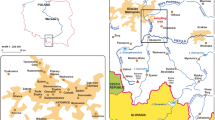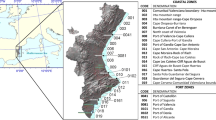Abstract
In order to document the impact of Best Available Techniques (BAT) and implementation of regulation on the improvement of the coastal marine environment state, we examined the case of a representative steel mill located at the Gulf of Elefsis (Greece). The evaluation of metal pollution was based on the analysis of major and trace elements, organic carbon, magnetic properties, and sediment accumulation rates, in sediment cores obtained from the vicinity of the plant. The analytical data are discussed in relation to steel production, changes of production routes, and adoption of BAT introduced in order to fulfill EU and national legislation. The results show that the input of pollutants to sediments and the degree of contamination were reduced by approximately 40–70% in the decade 2003–2015 in comparison to the periods of high discharges (1963–2002), whereas the toxicity risks from “high-to-extremely high” were reduced to “medium-to-high.”






Similar content being viewed by others
References
Abrahim, G. M. S., & Parker, R. J. (2008). Assessment of heavy metal enrichment factors and the degree of contamination in marine sediments from Tamaki Estuary, Auckland. New Zealand. Environmental Monitoring and Assessment, 136(1–3), 227–238.
Anderson, R. F., Schill, R. L., & Hesslein, R. H. (1987). Determining sediment accumulation and mixing rates using 210Pb and 137Cs and other tracers. Canadian Journal of Fisheries and Aquatic Sciences, 44, 231–250.
Argyraki, A., & Kelepertzis, E. (2014). Urban soil geochemistry in Athens, Greece: the importance of local geology in controlling the distribution of potentially harmful trace elements. Science of the Total Environment, 482-483, 366–377.
Audry, S., Schäfer, J., Blanc, G., & Jouanneau, J. M. (2004). Fifty-year sedimentary record of heavy metal pollution (Cd, Zn, Cu, Pb) in the Lot River reservoirs (France). Environnemental Pollution, 132(3), 413–426.
Bellucci, L. G., Frignani, M., Paolucci, D., & Ravanelli, M. (2002). Distribution of heavy metals in sediments of the Venice Lagoon: the role of the industrial area. Science of the Total Environment, 295, 35–49.
Blaha, U., Appel, E., & Stanjek, H. (2008). Determination of anthropogenic boundary depth in industrially polluted soil and semi-quantification of heavy metal loads using magnetic susceptibility. Environmental Pollution, 156, 278–289. https://doi.org/10.1016/j.envpol.2008.02.013.
Blundell, A., Hannam, J. A., Dearing, J. A., & Boyle, J. F. (2009). Detecting atmospheric pollution in surface soils using magnetic measurements: a reappraisal using an England and Wales database. Environmental Pollution, 157, 2878–2890.
Botsou, F., Karageorgis, A. P., Dassenakis, E., & Scoullos, M. (2011). Assessment of heavy metal contamination and mineral magnetic characterization of the Asopos River sediments (Central Greece). Marine Pollution Bulletin, 62(3), 547–563.
Buccolieri, A., Buccolieri, G., Cardelicchio, N., Dell’ Atti, A., Di Leo, A., & Maci, A. (2006). Heavy metals in marine sediments of Taranto Gulf (Ionian Sea, Southern Italy). Marine Chemistry, 99, 227–235.
Cundy, A. B., Croudace, I. W., Cearreta, A., & Irabien, M. J. (2003). Reconstructing historical trends in metal input in heavily-disturbed, contaminated estuaries: studies from Bilbao, Southampton Water and Sicily. Applied Geochemistry, 18(2), 311–325. https://doi.org/10.1016/S0883-2927(02)00127-0.
Daszykowski, M., Kaczmarek, K., Vander Heyden, Y., & Walczak, B. (2007). Robust analysis—a review: basic concepts. Chemometrics and Intelligent Laboratory Systems, 85, 203–219. https://doi.org/10.1016/j.chemolab.2006.06.016.
Dearing, J. A., Dann, R. J. L., Hay, K., Lees, J. A., Loveland, P. J., Maher, B. A., & O'Grady, K. (1996). Frequency-dependent susceptibility measurements of environmental materials. Geophysical Journal International, 124(1), 228–240.
European Commission (2013) Best Available Techniques (BAT) reference document for iron and steel production. Industrial Emissions Directive 2010/75/EU. JRC 69967, EUR 25521 EN, https://doi.org/10.2791/97469.
Gaudette, H. E., Flight, W. R., Toner, L., & Folger, D. W. (1974). An inexpensive titration method for the determination of organic carbon in recent sediments. Journal of Sedimentary Petrology, 144, 249–253.
Hakanson, L. (1980). Ecological risk index for aquatic pollution control: a sedimentological approach. Water Research, 14, 975–1001. https://doi.org/10.1016/0043-1354(80)90143-8.
Javaid, A., Essadiqi, E. (2003). Final report on scrap management, sorting and classification of steel. Government of Canada, Report No. 2003-23(CF), p. 22.
Kalogeropoulos, N., Scoullos, M., Vassilaki-Grimani, M., & Grimanis, A. P. (1989). Vanadium in particles and sediments of the northern Saronikos Gulf, Greece. Science of the Total Environment, 79, 241–252.
Karageorgis, A. P., Anagnostou, C. L., & Kaberi, H. (2005). Geochemistry and mineralogy of the NW Aegean Sea surface sediments: implications for river runoff and anthropogenic impact. Applied Geochemistry, 20, 69–88. https://doi.org/10.1016/j.apgeochem.2004.07.008.
Karageorgis, A. P., Katsanevakis, S., & Kaberi, H. (2009). Use of enrichment factors for the assessment of heavy metal contamination in the sediments of Koumoundourou Lake, Greece. Water Air and Soil Pollution, 204, 243–258.
Li, Y., Arocena, J. M., Zhang, Q., Thring, R. W., & Li, J. (2017a). Heavy metals and nutrients (carbon, nitrogen, and phosphorus) in sediments: relationships to land uses, environmental risks, and management. Environmental Science and Pollution Research, 24, 7403–7412. https://doi.org/10.1007/s11356-017-8385-y.
Li, Z., Nie, X., He, J., Chang, X., Liu, C., & Sun, L. (2017b). Characteristics of sediment-bound organic carbon loss during water erosion: a case study of four typical loess soils in Shaanxi Province. Catena, 156, 393–400.
Long, E. R., & MacDonald, D. D. (1998). Recommended uses of empirically derived, sediment quality guidelines for marine and estuarine ecosystems. Human and Ecological Risk Assessment: An International Journal, 4(5), 1019–1039.
Long, E. R., Macdonald, D. D., Smith, S. L., & Calder, F. D. (1995). Incidence of adverse biological effects within ranges of chemical concentrations in marine and estuarine sediments. Environmental Management, 19(1), 81–97.
Long, E. R., Field, L. J., & MacDonald, D. D. (1998). Predicting toxicity in marine sediments with numerical sediment quality guidelines. Environmental Toxicology and Chemistry, 17(4), 714–727.
Long, E. R., MacDonald, D. D., Severn, C. G., & Hong, C. B. (2000). Classifying the probabilities of acute toxicity in marine sediments with empirically derived sediment quality guidelines. Environmental Toxicology and Chemistry, 19, 2598–2601.
Long, E. R., Ingersoll, C. G., & MacDonald, D. D. (2006). Calculation and uses of mean sediment quality guideline quotients: a critical review. Environmental Science and Technology, 40, 1726–1736.
Loska, K., & Wiechula, D. (2003). Application of principal component analysis for the estimation of source of heavy metal contamination in surface sediments from the Rybnik Reservoir. Chemosphere, 51, 723–733.
Mackereth, F. J. H. (1969). A short core sampler for sub-aqueous deposits. Limnology and Oceanography, 14, 145.
Massas, I., Ehaliotis, C., Kalivas, D., & Gasparatos, D. (2013). Total and available heavy metal concentrations in soils of the Thriassio plain (Greece) and assessment of soil pollution indexes. Environmental Monitoring and Assessment, 185, 6751–6766.
Mayer, L. M., & Fink, L. K. (1980). Granulometric dependence of chromium accumulation in estuarine sediments in Maine. Estuarine, Coastal and Shelf Science, 11, 491–503.
Miralles, J., Radakovitch, O., & Aloisi, J. C. (2005). 210Pb sedimentation rates from the Northwestern Mediterranean margin. Marine Geology, 216, 155–167.
Oldfield, F., Maher, B. A., Donoghue, J., & Pierce, J. (1985). Particle size related, mineral magnetic source sediment linkages in the Rhode River catchment, Maryland, USA. Journal of the Geological Society, 142, 1035–1046.
Oldfield, F., & Scoullos, M. (1984). Particulate pollution monitoring in the Elefsis Gulf: the role of mineral magnetic studies. Marine Pollution Bulletin, 15(6), 229–231.
Pekey, H., Karakas, D., Ayberk, S., Tolun, L., & Bakoglu, M. (2004). Ecological risk assessment using trace elements from surface sediments of Izmit Bay, (Northeastern Marmara Sea) Turkey. Marine Pollution Bulletin, 48, 946–953.
Reimann, C., Filzmoser, P., & Garrett, R. G. (2002). Factor analysis applied to regional geochemical data: problems and possibilities. Applied Geochemistry, 17, 185–206. https://doi.org/10.1016/S0883-2927(01)00066-X.
Salomons, W., & Forstner, U. (1984). Metals in the hydrocycle. Berlin, Heidelberg, New York, Tokyo: SpringerVerlag.
Sanchez-Cabeza, J. A., Masque, P., & Ani-Ragolta, I. (1998). Pb-210 and Po-210 analysis in sediments and soils by microwave acid digestion. Journal of Radioactivity and Nuclear Chemistry, 227, 19–22.
Savvides, C., Papadopoulos, A., Haralambous, K. J., & Loizidou, M. (1995). Sea sediments contaminated with heavy metals: metal speciation and removal. Water Science and Technology, 32(9–10), 65–73.
Schmidt, A., Yarnold, R., Hill, M., & Ashmore, M. (2005). Magnetic susceptibility as proxy for heavy metal pollution: a site study. Journal of Geochemical Exploration, 85, 109–117. https://doi.org/10.1016/j.explo.2004.12.001.
Scoullos, M., Botsou, F., & Zeri, C. (2014). Linking environmental magnetism to geochemical studies and management of trace metals. Examples from fluvial, estuarine and marine systems. Minerals, 4, 716–745.
Scoullos, M. (1979). Chemical studies of the gulf of Elefsis, Greece. PhD Thesis, University of Liverpool.
Scoullos, M. (1981). Zinc in seawater and sediments of the Gulf of Elefsis, Greece. Water Air and Soil Pollution, 16(2), 187–207.
Scoullos, M., Oldfield, F., & Thompson, R. (1979). Magnetic monitoring of marine particulate pollution in the Elefsis Gulf, Greece. Marine Pollution Bulletin, 10(10), 287–291.
Scoullos, M. J. (1986). Lead in coastal sediments: the case of the Elefsis Gulf, Greece. Science of the Total Environment, 49(0), 199–219.
Scoullos, M. J., & Oldfield, F. (1986). Trace metal and magnetic studies of sediments in Greek estuaries and enclosed gulfs. Marine Chemistry, 18(2–4), 249–268.
Simeonov, V., Stratis, J. A., Samara, C., Zachariadis, G., Voutsa, D., Anthemidis, A., Sofoniou, M., & Kouimtzis, T. (2003). Assessment of the surface water quality in Northern, Greece. Water Research, 37(17), 4119–4124.
Tabachnick, B., Fidell, L. (1996). Using multivariate statistics, 3rd ed.(p 880). New York: HarperCollins College Publishers.
Thompson, R., Oldfield, F. (1986). Environmental magnetism (pp. 227). London: Allen and Unwin.
Worrell, E., Price, L., Martin, N., Farla, J., & Schaeffer, R. (1997). Energy intensity in the iron and steel industry: a comparison of physical and economic indicators. Energy Policy, 25(7–9), 727–744.
World Steel Association (2008). Sustainability report of the world steel industry. https://www.worldsteel.org/en/dam/jcr:e6f75b6a-5c2a-4690-94f8-72f82bb674a0/2008.pdf. Accessed October 2008.
Yan, J., Gong, J. L., Zeng, G. M., Song, B., Zhang, P., Liu, H. Y., Huan, S. Y., & Li, X. D. (2017). Carbon nanotube-impeded transport of non-steroidal anti-inflammatory drugs in Xiangjiang sediments. Journal of Colloid and Interface Science, 498, 229–238.
Zhang, C., Qiao, Q., Piper, J. D. A., & Huang, B. (2011). Assessment of heavy metal pollution from a Fe-smelting plant in urban river sediments using environmental magnetic and geochemical methods. Environmental Pollution, 159, 3057–3070.
Zonta, R., Zaggia, L., & Argese, E. (1994). Heavy metal and grain-size distribution in estuarine shallow water sediments of the Cona Marsh (Venice, Lagoon, Italy). Science of the Total Environment, 151, 19–28.
Acknowledgements
The authors would like to thank the anonymous reviewers for their valuable comments.
Funding
The current research was co-funded through the European Union and the Hellenic General Secretariat for Research and Technology ARISTEIA Research Program “Integrated Study of trace METals biogeochemistry in the COastal MARine ENvironment (ISMET-COMAREN/640, research grant 70/3/11903) as well as through “Horizon 2020” Capacity Building, Mediterranean Environmental Programme (CB/MEP; ENPI/2009/220-191) for sampling and experiments.
Author information
Authors and Affiliations
Corresponding author
Rights and permissions
About this article
Cite this article
Panagiotoulias, I., Botsou, F., Kaberi, H. et al. Can we document if regulation and Best Available Techniques (BAT) have any positive impact on the marine environment? A case based on a steel mill in Greece. Environ Monit Assess 189, 598 (2017). https://doi.org/10.1007/s10661-017-6324-5
Received:
Accepted:
Published:
DOI: https://doi.org/10.1007/s10661-017-6324-5




